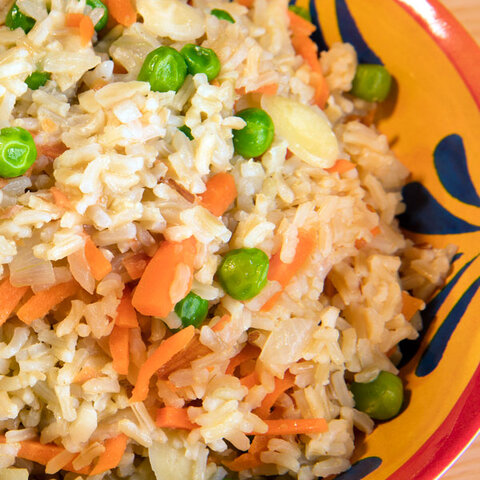
Enjoy the health benefits of a daily handful of nuts or a couple of tablespoons of seeds by sprinkling them on cereal, yogurt, salads, soups, pasta and vegetables. Toast them for added flavor. You can toast them using your microwave, oven or stove-top.
Microwave Toasting
Here's a quick and cool way (with minimal clean-up) to toast nuts and seeds:
This method works well for amounts ranging from a tablespoon to ½ cup. With larger amounts, some are likely to turn dark quicker than others. The time will vary depending on the size, type and temperature of the nuts/seeds and also may be influenced by the type of microwave.
- Spread from a tablespoon to ½ cup nuts or seeds evenly in a single layer in a flat, microwave-safe dish, such as a 9-inch microwave-safe pie plate.
- Add a small amount of soft butter or margarine or add a small amount of oil to the nuts/seeds. Use about ½ teaspoon fat per ½ cup of nuts/seeds; use proportionally less for smaller amounts of nuts/seeds. Stir the nuts/seeds to thinly coat with the fat. This small amount of fat helps with browning and speeds up the toasting process.
- Microwave on high for 1 minute. Stir and microwave for another minute.
- Check to see how the toasting is proceeding. Add more microwave cooking time one minute at a time because nuts and seeds can burn quickly. Stir after each addition of time.
- Small amounts of thin nuts/seeds (sliced almonds or sesame seeds) could be finished at 2 minutes. Larger amounts of nuts, such as slivered or whole almonds, walnuts, pecans and sunflower seeds will take an additional minute or two more microwaving to become lightly browned and smell fragrant.
- Store any extra toasted nuts or seeds in an airtight container in the refrigerator for 1 to 2 weeks or freeze them in an airtight freezer container for 1 to 3 months.
Oven Toasting
- Preheat oven to 350 °F.
- Toast nuts BEFORE chopping them into smaller pieces.
- Place nuts or seeds in a single layer in an ungreased shallow pan or RIMMED baking sheet such as a cookie sheet or jelly roll pan. (DO NOT use a baking sheet without sides. You may have nuts or seeds all over the oven if you accidentally tip the sheet when removing it from the oven.)
- Bake 5 to 10 minutes or until they are GOLDEN brown. A toasted nut or seed may look more GOLDEN than BROWN. They will continue to brown slightly after they're removed from the oven. Stir once or twice or shake the pan during toasting to aid in even browning.
- Remove from pan to cool.
- Store any extra toasted nuts or seeds in an airtight container in the refrigerator for 1 to 2 weeks or freeze them in an airtight freezer container for 1 to 3 months.
NOTE: The first time you try toasting nuts or seeds, it's better to err on the side of under-toasting than over-toasting. As they toast, you'll notice a change in their fragrance as well as their color.
Stovetop Toasting
Stovetop toasting works well for small batches of nuts or seeds. With this method, the parts of the nuts or seeds touching the skillet may become darkest, unlike the oven method where they become more of an overall golden color.
- Toast nuts BEFORE chopping them into smaller pieces.
- Heat nuts or seeds in a dry, heavy skillet over medium heat for 1 to 2 minutes or until they're golden brown and they give off a rich, toasty fragrance. Watch them closely when using this method as it's easy to burn them.
- Stir or toss nuts or seeds frequently for even toasting.
- Remove from pan to cool.
- Store any extra toasted nuts or seeds in an airtight container in the refrigerator for 1 to 2 weeks or freeze them in an airtight freezer container for 1 to 3 months.
Source:
Go Nuts! United States Department of Agriculture (USDA)
This article was originally written by Alice Henneman. It was reviewed and updated in 2022.
Tags:







